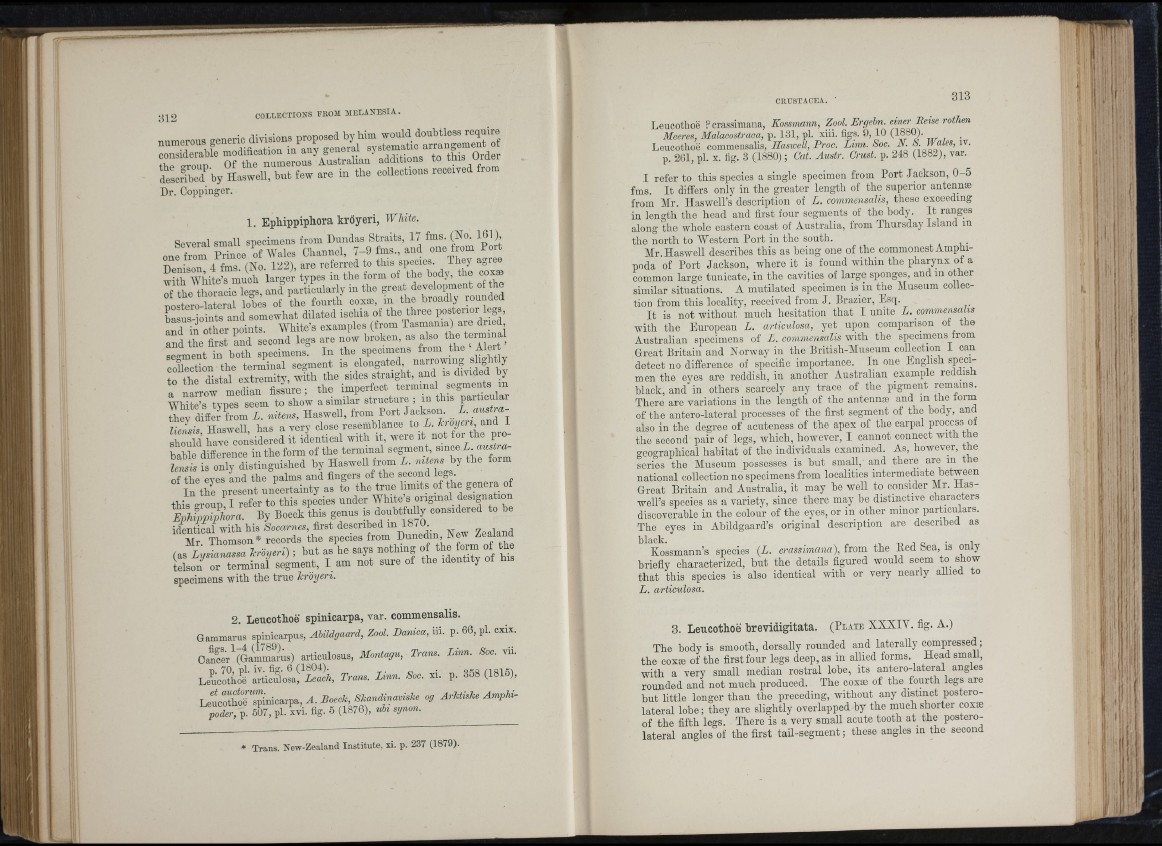
3 1 2 COLLECTIONS FKOM MELANESIA.
the o-rouT) Of the numerous Australian auuLuuiis
delribed by Haswell, b,.t tew are in the coUecUons received from
Dr. Coppinger.
1. Ephippiphora kroyeri, White.
Several small specimens from Dundas Straits, 17 fms. (No. 161 ),
un w u k p k mnoh lar°-er types in the form of the body, tne coxæ
I f the thoracic legs, and particularly in the great development ot the
l + e r o - l l r a l lobes of the fourth coxæ, in the broadly rounded
Lsus-ioints and somewhat dilated ischia of the three posteiior kgs,
and in other points. AVhite’s examples (from Tasmania) are drmd
: f d t i e firet L d second legs are now broken, as also the t e r™ ^
seo-ment in both specimens. In the specimens from the Ale
colkction the terminal segment is elongated, narrowing s ightly
to the distal extremity, with the sides straight, and is diyided h j
a T a k w median i s A e , the imperfect termina segments in
White’s types seem to show a similar structure ; in this particular
th e r d i f e H S m L. n,Um, Haswell, from Port Jackson. L. « » tm -
T "ok Dn^wpll has a very close resemblance to L. Icroyeri, and
should h aw considered it identical with it, were it not for the probable
difference in the form of the terminal seg-ment, since L .a u s tr ^
“ is only distinguished by Haswell from A. m t ^ s hy the form
of the eyes and the palms and fingers of the second legs.
in t £ present uncertainty as to the true limits of the genera of
this sroun I refer to this species under White’s original designation
Ephippiphora. By Boeck this genus is <io[‘btfully considered to be
iflentical with his Socarnes, first described in 1870 ,7 , v
MÎ Thornson* records the species f - -
(as Lysianassa kroyeri) ; but as he says nothing of
L o n or terminal segment, I am not sure of the identity of his
specimens with the true Tcroyen.
2. Leucothoe spiuicarpa, var. coiumeusalis,
Gammanis spmicarpus, Ahildcjaard, Zool. Danica, iii. p. 66, pi. cxix.
C a ? S l ^ ( l S u s ) articnlosus, Montagu, Trans. Linn. Soc. vii.
L e u c S h o t L c u k l f w i , Trans. Linn. Soc. xi. p. 358 (1815),
L e lo S “ micarpa, A. Boech, Skandinaviske og Arktiske Amphipoder,
p. 507, pi. xvi. fig. 5 (1876), ubi synon.
Trans. New-Zealand Institute, xi. p. 237 (1879).
Leucothoe ? crassimana, Kossmann, Zool. Ergebn. einer Reise rothen
Meeres, Malaeostraca, p. 131, pi. xiii. figs. 9, 10 (18*50). _
Leucothoe commensalis, Haswell, Proc. Linn. Soc. N. S - ^ ^ >
p. 261, pi. X. fig. 3 (1880) ; Cat. Austr. Crust, p. 248 (1882), var.
I refer to this species a single specimen from Port Jackson, 0 -5
fms. I t differs only in the greater length of the superior antennse
from Air. HaswelPs description of L. commensalis, these exceeding
in length the head and first four segments of the body. I t ranges
along the whole eastern coast of Australia, from Thursday Island in
the north to AVestern Port in the south.
Air. Haswell describes this as being one of the commonest Ampni-
poda of Port Jackson, where it is found within the pharynx of a
common large tunicate, in the cavities of large sponges, and in other
similar situations. A mutilated specimen is in tue Aluseum collection
from this locality, received from J. Brazier, Esq.
I t is not without much hesitation th at I unite L. commensalis
with the European L. articulosa, yet upon comparison of the
Australian specimens of L. commensalis with the specimens from
Great Britain and Norway in the British-AInseum collection 1 can
detect no difference of specific importance. In one English specimen
the eyes are reddish, in another Australian example reddish
black, and in others scarcely any trace of the pigment remains.
There are variations in the length of the antenna; and in the torm
of the antero-lateral processes of the first segment of the body, and
also in the degree of acuteness of the apex of the carpal process of
the second pair of legs, which, however, I cannot connect with the
geographical habitat of the individuals examined. As, however, the
series the Aluseum jiossesses is but small, and there are in the
national collection no specimens from localities intermediate between
Great Britain and Australia, it may he well to consider Mr. D^as-
welPs species as a variety, since there may be distinctive characters
discoverable in the colour of the eyes, or in other minor particulars.
The eyes in Abildgaard’s original description are described as
Kossmann’s species (A. crassimana), from the lied Sea, is only
briefly characterized, hut the details figured would seem to show
th a t this species is also identical with or very nearly allied to
L. articulosa.
3 . Leucothoe hrevidigitata. ( P l a t e XXXIV. fig. A.)
The body is smooth, dorsally rounded and laterally compressed ;
the coxæ of the first four legs deep, as in allied forms. Head small,
with a very small median rostral lobe, its antero-lateral angles
rounded and not much produced. The coxæ of the fourth legs are
but little longer than tho preceding, without any distinct posterolateral
lobe ; they are slightly overlapped by the much shorter coxæ
of th e fifth legs. There is a very small acute tooth at the posterolateral
angles of the first tafi-segment ; these angles in the second
.1 ;
Ü ■ i| '
ii ! :
I
a 1 M ll
Ui ti
A m
' i:
i,.|;
i' I
I l f
Í • i.
'i ‘i.r
I H *
1 : I I